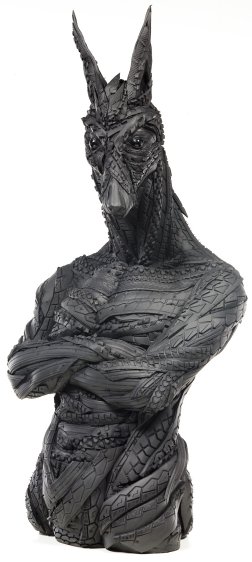Korean scuplts anthropomorphic animals from recycled tires
 Anthropomorphic jackals, wolf-men, horses and wild boar - all made of used tires, resin, steel and foam. These are the work of Yong Ho Ji, a Korean whose art has toured the world, from Seoul to Amsterdam.
Anthropomorphic jackals, wolf-men, horses and wild boar - all made of used tires, resin, steel and foam. These are the work of Yong Ho Ji, a Korean whose art has toured the world, from Seoul to Amsterdam.
Yong, who has an M.F.A. in fine arts from NYU and a B.F.A. in sculpture from Hongik University in Seoul, originally formed his pieces from welded iron bones, wooden planks and soil, overlaid with tires, before turning for a while to death-castings. Nowadays, he works in tire-wrapped resin formed on plaster molds.
Within the medium, there is great scope for choice in materials, as noted by Trinie Dalton:
A deer's tender cheekbones and muzzle are rendered with lightly treaded road-bike tires and smooth inner tubes, lining its eye sockets and nostrils to conjure a quizzical expression. The burly neck and forehead of a steadfast rhinoceros uncannily resembles a real rhino's bust because of the broadly treaded tractor tires peering out, like anger-strained tendons, from beneath a rough outer skin made of motorcycle tires.
Some species seem more popular than others; his gallery displays a multitude of deer and eleven models of shark, but only one mink. Herbivores feature on an equal basis - there's even a zebra. [tip: JayGryph]
Just as Yong refined his methods over the years, so his work evokes an evolution: from raw use of the world's natural resources, to appreciation of the strength and beauty of the creatures inhabiting it. The powerful, often-mutated structures also send a message, as noted by art critic Ryu Han-Seung:
Generally speaking, people perceive mutants as abnormal and inferior creatures. If mutants obtain abilities superior to the originals and if they become more valuable, how would people perceive these creatures? Probably they would recognize these animals as ‘normal’ beings and would treat the originals as ‘abnormal’ beings. The line separating normal from abnormal is quite vague and the line is frequently re-drawn with changes in society and time.
The majority of Yong's animals are non-anthropomorphic, and budding commissioners may have to wait; it can take months for him to complete a piece. Still, judging by the backgrounds to his latest works, the corporate art world has taken an interest in his industrial yet environmentally-conscious sculptures.

About the author
GreenReaper (Laurence Parry) — read stories — contact (login required)a developer, editor and Kai Norn from London, United Kingdom, interested in wikis and computers
Small fuzzy creature who likes cheese & carrots. Founder of WikiFur, lead admin of Inkbunny, and Editor-in-Chief of Flayrah.
Comments
Just looking at what it is shown here I can imagine the rest is amazing. The strips making up the arms remind me of how things look at Body Worlds (display of plastinated bodies). I doubt the average fur would be able to afford this sort of thing though. If it takes months to make then the labour cost is going to be huge.
"If all mankind minus one, were of one opinion, and only one person were of the contrary opinion, mankind would be no more justified in silencing that one person, than he, if he had the power, would be justified in silencing mankind."
~John Stuart Mill~
Post new comment